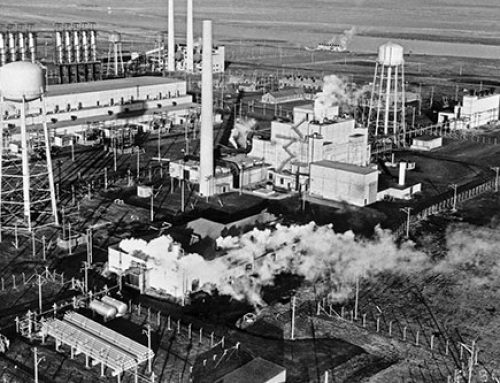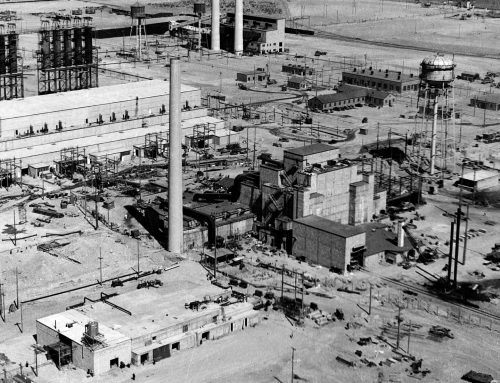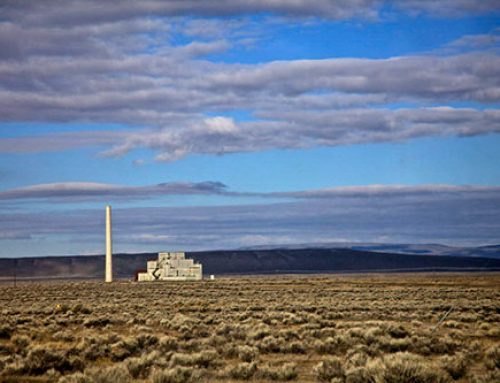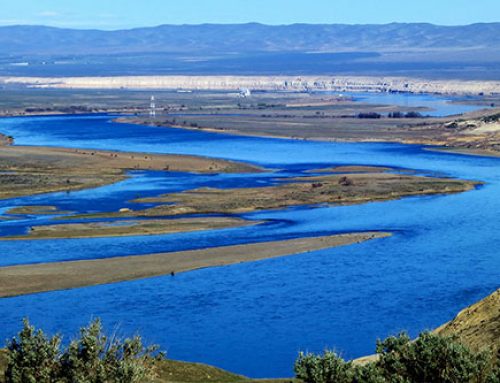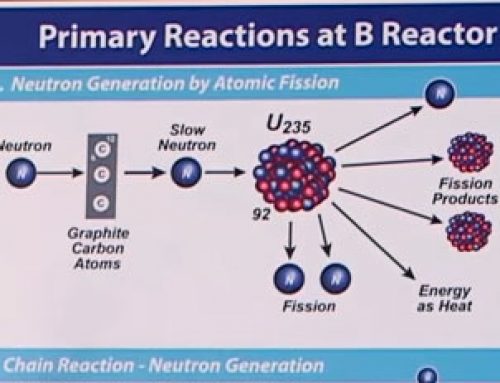B Reactor 60th Anniversary keynote address
Richard Rhodes
Pulitzer Prize-winning author Richard Rhodes was the keynote speaker at the Hanford and History 60th Anniversary commemoration. Rhodes is author of The Making of the Atomic Bomb, the definitive history of the Manhattan Project.
 Many of you know the history of the Hanford Engineer Works well; some of you lived it. I know it as a historian. I researched it through mostly secondary sources to write about it, rather briefly, in my book The Making of the Atomic Bomb. (I would have written more, but I simply didn’t have room, so I treated plutonium production to some extent as a black box, inadvertently contributing to the myth that the atomic bomb was the work of 30 theoretical physicists at Los Alamos.) More recently I’ve reviewed boxes and boxes of primary sources to refresh my memory of the heroic work carried out here between 1943 and 1945. So I think I can speak with some authority about it. I may even be able to clear up a mystery or two.
Many of you know the history of the Hanford Engineer Works well; some of you lived it. I know it as a historian. I researched it through mostly secondary sources to write about it, rather briefly, in my book The Making of the Atomic Bomb. (I would have written more, but I simply didn’t have room, so I treated plutonium production to some extent as a black box, inadvertently contributing to the myth that the atomic bomb was the work of 30 theoretical physicists at Los Alamos.) More recently I’ve reviewed boxes and boxes of primary sources to refresh my memory of the heroic work carried out here between 1943 and 1945. So I think I can speak with some authority about it. I may even be able to clear up a mystery or two.
Scientists at the Metallurgical Laboratory of the University of Chicago determined the parameters of the site where plutonium would be produced for the first atomic bombs. Thirty-three-year-old Army Corps of Engineers Colonel Franklin T. Matthias, known to his friends as “Fritz,” wrote them into his diary after a meeting at DuPont’s home offices in Wilmington, Delaware, on December 14, 1942: The site needed to be spacious enough to accommodate a manufacturing area of approximately 12 by 16 miles, with no public highway or railroad nearer than 10 miles , no town of greater than 1,000 population nearer than 20 miles, an available water supply of at least 25,000 gallons per minute and an electrical supply of at least 100,000 kilowatts. Matthias looked in the Grand Coulee area of Washington and at several sites in Tennessee before flying over Hanford in an Army observation plane. “I came back over Horse Heaven,” he remembered many years later— “in the area northeasterly from Plymouth—and over Rattlesnake Mountain to the Hanford site from the west, and I got over that mountain, and I had looked at everything else, and I knew that was it, right then.” His boss, Brigadier General Leslie Richard Groves, agreed, and the Corps of Engineers began land appraisals at the Hanford site in January 1943.
The first great question was what kind of cooling system to use in the production reactors that would be built and operated at Hanford to make plutonium. Graphite would serve as moderator, uranium metal as fuel. The fission chain reaction would release tens and hundreds of thousands of kilowatts of energy, and since these reactors were being built to breed plutonium, that energy would not be used to make steam to generate electricity but would have to be transferred away. The first chain reaction in the squash court pile at the University of Chicago had operated with a barely positive reactivity of 1.006, so conserving neutrons was an important consideration. Helium, which absorbed no neutrons at all, was the coolant of choice at first, but Hungarian theoretical physicist Eugene Wigner, trained as an engineer, held out for water despite its neutron-scavenging propensities because it would be simpler and thus faster to engineer. Wigner judged that they would improve reactivity in the big production reactors with purer materials. He was convinced that Nazi Germany was ahead of the United States in bomb development, and even moved his family out of Chicago in December 1943, when he estimated the German head start might have given them atomic bombs—which he thought Germany would, logically, drop on the Met Lab. Eventually Enrico Fermi, General Groves and DuPont’s Crawford Greenewalt came round to once-through water cooling. Wigner designed an elegant reactor: a three-story assembly of graphite blocks drilled through with a cylindrical lattice of channels into which could be inserted slugs of uranium metal clad with aluminum. Water from the Columbia River would flow through the channels around the slugs for cooling, and when the slugs had been sufficiently exposed to the pile’s neutron flux to breed about a dime’s weight of neptunium per ton of uranium, they could be pushed out the back into a cooling pool, where the neptunium would quickly decay to plutonium.
Which brings up one of the mysteries I mentioned. The B Reactor whose anniversary we’re celebrating this weekend was the first to go critical, late in the evening on September 26, 1944. Early the next morning the power was increased to 9 megawatts and held there. Then, to everyone’s surprise and consternation, the reactivity began slowly to decrease, at a rate that would drop the reaction below criticality at about six in the afternoon. To slow any possible water leak they reduced the pressure, which dropped the power to 200 kilowatts, but the reactivity continued to decline, and they decided to shut the reactor down and hunt for leaks.
When Crawford Greenewalt returned with Fermi the next morning, September 28, he wrote, he “found that the pile had died according to prediction, but had mysteriously come to life starting at about 1 a.m. today. The reactivity had increased steadily,” Greenewalt continues, “and at 7 a.m. they started controlling the power at 0.2 MW. From this time on the activity kept increasing….During the night an attempt had been made to find leaks but neither conclusively or successfully.” They continued trying to check for leaks, but by now they had come to believe that something was poisoning the reaction, and that evening, to test their suspicion, they raised the power to 9 MW, Greenewalt wrote in his diary, “and the earlier phenomenon repeated itself almost exactly: the reactivity first flattened off, then decreased…. At midnight we dropped the power again to 0.2 MW and when I left at 2:30 a.m. the loss of reactivity was decreasing and looked definitely as though it was going to turn up.”
Since the reactivity seemed to be cycling with the increase and then decrease of the poison, they thought of two possible explanations: either the reactor’s radiation was causing some substance to deposit on the slugs and tubes—which the cooling water then dissolved off when the pile power was reduced—or some short-lived fission product was decaying to a longer-lived radioactive daughter with a large appetite for neutrons. From the data on the changes in the pile reactivity Greenewalt plotted the half-life of the daughter at 11.7 hours, but, he wrote, they “couldn’t think of any reasonable radioactive process which would produce the results.”
By the morning of Friday, September 29, however, physicist John Wheeler had solved the mystery. The offender was a fission chain after all. The most likely, Wheeler thought, was 6.6-hour iodine134 decaying to 9.1-hour xenon135. The loss of reactivity the xenon had caused meant it had thirty times the appetite for neutrons of any isotope previously known. Wheeler calculated that they could override the poisoning by increasing the pile’s reactivity by 1.3 percent, which they could do by loading more channels with slugs—up to 1,500 channels and, if necessary, 2,000.
Why was the reactor built with extra, unused channels? The accepted explanation, which I think may have come from postwar reminiscences by Fritz Matthias, is that DuPont engineers were conservative and wanted to leave a margin of safety in case a problem cropped up. In contrast, Wigner, trusting his calculations and wanting to move ahead as fast as possible to beat the Germans, had designed a lattice—the horizontal cylindrical arrangement I mentioned—that made optimum use of the minimum necessary number of channels. But it wasn’t simply DuPont conservatism that led Crawford Greenewalt to order extra channels drilled through the corners of the cubical graphite structure. John Wheeler had assured Greenewalt that there were no unknown decay products that would poison the chain reaction, and Greenewalt seems to have accepted Wheeler’s assurances. (Wheeler’s overconfidence may explain why he hustled so quickly to identify the isotopes that DID cause the poisoning.) Greenewalt was in fact concerned with a different problem: water corrosion of the cladding around the uranium slugs, which could lead to leakage of the highly radioactive fission products into the cooling water and thus into the environment. It was possible, he realized, that the uranium slugs might have to be double-canned to prevent them from corroding, in which case the extra aluminum might scavenge enough neutrons to quench the chain reaction. To prepare for that possibility, Greenewalt ordered the corners of the reactor blocks drilled with extra channels where more uranium might be inserted, changing the pattern of the lattice from a cylinder to a cube to increase the reactor’s flux and override the aluminum can problem if it emerged—and fortuitously, the channels were then available to override the xenon poisoning no one had expected. Greenewalt’s decision was crucial, and he made it despite contrary advice from the Met Lab leadership. Had DuPont followed the Met Lab’s overconfident advice, the entire Hanford plutonium production program would have been stalled until new production piles could be designed and built, and the United States would have produced only one atomic bomb, the uranium bomb, Little Boy, in time to affect the outcome of the war. The new channels were quickly lined, piped and loaded, and on November 24, 1944, the B Reactor’s first irradiated slugs were pushed into the cooling pool.
The D reactor went critical on December 17, 1944, at 11:11 in the morning, and on December 26, the first charge of B reactor metal was dissolved in separation building 200-N.
By then, the Hanford Engineer Works was the third largest city in the state of Washington, a thriving society that Fritz Matthias oversaw. The baseball season had opened the previous summer when six crafts had fielded teams. Where orchards and dusty scablands had been, a community of almost 50,000 people had sprung to life a safe distance south of the futuristic piles and canyons and was finding its identity. “At the game Sunday,” Matthias noted proudly, “there were probably 5000 people watching. The plan is that three games will be played every Sunday until the end of the season.” There were churches now in the Hanford residential areas as well as schools, bars, barber shops and beauty salons. Native Americans still pulled salmon from the river in season at a camp that dated back to the days of Lewis and Clark; Matthias supplied the tribe with trucks to haul its salmon out, since the camp was within the secure area.
Six plutonium extraction runs were processed during January 1945, resulting in a “charge” of plutonium of 97 percent purity. “The charge was loaded into a ‘sample can’…on February 1, 1945,” the DuPont History reports. “Because the closure on the sample cans had been shown to have a high probability of leakage,” the History explains, “it was decided to evaporate the product solution nearly to dryness after loading. This was done on the first and all subsequent shipments.” According to Matthias, the quantity involved was “72,000 units,” which probably means 720 grams—three-quarters of a kilogram—painstakingly extracted from tens of tons of uranium. Matthias himself made the delivery, on February 5, 1945: “I drove from Hanford to Portland,” he remembered. “I had a guy with me and we had a locked space on the train from Portland to Los Angeles. [The container with the plutonium was] about a two-foot cube, wrapped up in wrapping paper and ropes, and inside was a test-tube thing suspended and secured—all surrounded by lead and rigged so it stayed right in the middle of that box. It was quite a heavy thing, and I carried it just like a box any traveler might have with him.”
F Reactor went critical on February 25, 1945, and another shipment of “product” left Hanford on March 1. The F Reactor was soon running smoothly, one of three now that were breeding plutonium around the clock. Matthias was able to inform Groves early in March that 10 kilograms of plutonium—enough for two bombs—would be ready for shipping between April 18 and July 12. The first 5 kilograms would be used to test the implosion system Los Alamos had invented; the second 5 kilograms would be destined for Japan. In a memorandum Groves prepared for President Truman on April 23, 1945, after the death of Franklin Roosevelt, he resolves another mystery, whether we would have used the bomb on Germany had it been ready before the German surrender in May. “The target,” Groves says he told the President, “is and was always expected to be Japan.”
By May 3, Matthias calculated that 20 cans of plutonium—about 3 kilograms—had left Hanford for Los Alamos. After the initial deliveries, Matthias had begun shipping the cans by army ambulance to Salt Lake City, where they were transferred to another ambulance driven up from New Mexico. The shipments took only two days, start to finish, to reach Los Alamos, Matthias noted proudly in his diary, “far better than could be done by train.” He noted VE Day—Victory in Europe, the defeat of Nazi Germany—on May 8, prompting himself to make sure the War Department film “Two Down and One to Go” was shown to remind Hanford workers that the Allies had defeated Fascist Italy and Nazi Germany but were still fighting a war in the Pacific against the Japanese. He was happy with plutonium production results, which he attributed to “the reduction of initial cooling periods” which permitted “processing of pushed material at an earlier date than scheduled.” Col. Kenneth Nichols, Groves’s deputy, was able to write Los Alamos director Robert Oppenheimer on June 1 promising cumulated production and delivery of 7 kilograms of plutonium by 1 June, 13 kg by 1 July, 20 kg by 1 August, 26 kg by 1 September, 40 kg by 1 October and 54 kg by 31 October. At 5 kilograms per bomb, that would be enough for 10 bombs, with a little left over.
Oppenheimer had his first 5 kilograms by May 18. Los Alamos used it to fuel the first atomic bomb that was exploded on a hundred-foot tower in the desert north of Alamogordo in mid-July. Groves wrote a description, intended for President Truman’s eyes at Potsdam, of the successful test of the “Fat Man” plutonium implosion bomb fueled with Hanford plutonium:
At 0530, 16 July 1945, in a remote section of the Alamogordo Air Base, New Mexico, the first full scale test was made of the implosion type atomic fission bomb. For the first time in history there was a nuclear explosion. And what an explosion!
…The test was successful beyond the most optimistic expectations of anyone. Based on the data which it has been possible to work up to date, I estimate the energy generated to be in excess of the equivalent of 15,000 to 20,000 tons of TNT; and this is a conservative estimate….There were tremendous blast effects. For a brief period there was a lighting effect within a radius of 20 miles equal to several suns at midday; a huge ball of fire was formed which lasted for several seconds. This ball mushroomed and rose to a height of over ten thousand feet before it dimmed. The light from the explosion was seen clearly at Albuquerque, Santa Fe, Silver City, El Paso and other points generally to about 180 miles away. The sound was heard to the same distance in a few instances but generally to about 100 miles….
In his previous work as head of military construction, Groves had designed and built the Pentagon. Now at the end of his report he added his ultimate measure of the destructiveness of the new weapon: “I no longer consider the Pentagon a safe shelter from such a bomb.”
Hanford went public with President Truman’s announcement of the atomic bombing of Hiroshima on August 6, 1945. “By afternoon today,” Matthias wrote in his diary, “the project area around Richland was besieged with reporters, newsreel people and radio people to get first hand accounts of the story of Hanford for their newspapers and radio stations.” Matthias assessed Hanford morale in his diary entry for August 7: “The general attitude of the project employees both in the Government offices and the duPont Company offices,” he wrote, “is one of great relief and one of renewed enthusiasm for the job. In addition to the natural lift experienced by people all around this part of the country there is the consciousness in the minds of people directly working at the Hanford Project that they have contributed to the mechanism that will certainly end the war very soon.”
They had, and it did. After the United States bombed Nagasaki with a Fat Man bomb charged with Hanford plutonium that exploded with the force of 22,000 tons of TNT, the Japanese surrendered unconditionally on August 14, 1945. The Imperial rescript that the Emperor Hirohito recorded for broadcast to his people on that day, asking them to lay down their arms, answers the continuing debate whether or not the two bombs were necessary. The Japanese people had never heard Hirohito’s voice before. “Despite the best that has been done by everyone,” he told them, “…the war situation has developed not necessarily to Japan’s advantage, while the general trends of the world have all turned against her interest. Moreover, the enemy has begun to employ a new and most cruel bomb, the power of which to do damage is indeed incalculable, taking the toll of many innocent lives….This is the reason why We have ordered the acceptance of the provision of the Joint declaration of the Powers….
The B Reactor went on after the war to produce plutonium to fuel the burgeoning U.S. nuclear arsenal. Now we’re attempting to arrange its preservation as a historic site and a museum. Bills have passed both the House and the Senate funding a review by the National Park Service of preserving Manhattan Project sites in Tennessee, New Mexico and here in Washington as a distributed national park. Why should they be preserved? Should we be proud of the work of the Manhattan Project in the years of the Second World War? Should we be ashamed? Should we look the other way, or should we remember? Or are such questions inappropriate where the physical preservation of our common past is concerned? These are issues worth examining briefly on this anniversary occasion.
First of all, why preserve the physical remains of the past? Why are the Declaration of Independence and the U.S. Constitution maintained in elaborately sealed cases lowered at night into expensive bomb-proof vaults when there are perfectly readable copies around? Why preserve Williamsburg? Why St. Mary’s Mission or Fort Walla Walla? There are reasonably good scaled-down reconstructions at Disneyworld and in Las Vegas of everything from the Eiffel Tower to the Taj Mahal. And certainly many people go to such theme parks to view reconstructions without having to incur the trouble and expense of traveling to see the originals.
The answer isn’t necessarily mystical, but it is philosophical. For philosophy I turn to philosophers. The philosopher John Searle has examined this problem of what he calls “social reality.” The bombs the Manhattan Project built were physical objects that depended for their operation on physics, chemistry, metallurgy and other natural sciences, but their social reality — their meaning, if you will — was human, social, political. The same is true of Williamsburg and St. Mary’s Mission and the Declaration of Independence. “There are portions of the real world,” Searle writes, “objective facts about the world, that are only facts by human agreement. In a sense,” he goes on, “there are things that exist only because we believe them to exist. I am thinking of things like money, property, governments and marriages.”
Searle distinguishes between what he calls “institutional facts” — facts that require human institutions for their existence — and “brute facts.” Paper money, citizenship, property, the meaning of words, the high value of diamonds are institutional facts. Brute facts are the facts of the sciences and of the physical world — that the Columbia is a mighty river, that a hydrogen atom has one electron, that plutonium fissions and chain-reacts. Brute facts are facts of physical reality. Institutional facts are facts of social reality, which is every bit as real to us and as complexly structured as physical reality, but weightless and invisible.
I’m sure you see where this is going. We preserve what we value of the physical past because it specifically embodies our social past. However weightless and invisible social reality might be — I mean all the vast interconnections and communications we share together and with our forebears, all our records, experiences, photographs, poems, paintings, highways, inventions, celebrations, styles of everything from clothing to romantic love — that social reality is anchored in physical objects, starting with our own living bodies but extending far and deep into the physical world of landscapes, buildings, documents, machines and artifacts. Finding meaning in the preservation and contemplation of those physical objects isn’t merely sentimental, because the meaning isn’t merely an extra, an add-on. To the contrary, physical facts and social facts can and do occupy the same space at the same time.
Or to say it more simply: when we lose parts of our physical past we lose parts of our common social past as well. Anyone who has ever lost a wedding ring, or had an album of family photographs destroyed in a fire, knows exactly what I mean. Reproductions can give a sense of the past, but because they lack authentic social facticity they can never wholly substitute for the original, any more than copies of a painting can substitute for the original. And that uniqueness informs the purpose and justifies the expense of historic preservation.
But of course we don’t preserve all the past. We pick and choose. Every building where human beings have lived or worked is embedded densely with memories. Most of those memories are private, however; not many structures or artifacts embody historic transformations. There were log cabins everywhere in rural and frontier America, but only a few witnessed the births of poets or Presidents. Shops and laboratories and factories have fared even less well than birthplaces, perhaps because the historic events they nurtured were less universal as human experiences go and therefore less emotionally resonant — were invention and discovery rather than birth and marriage and death. Nor do we often preserve places where we did things we’re ashamed of, except to educate future generations and to memorialize and commemorate the victims.
Where does the Manhattan Project fit in this spectrum of values? Do what’s left of its historic structures deserve preservation? How will history judge it? Was it a great achievement? Or was it, as some have accused, a monument to man’s inhumanity to man?
When Robert Oppenheimer recruited scientists for Los Alamos, he was restrained by the requirements of national security from telling them what their work would be. So he found an equivalent that appealed to their patriotism and altruism. He walked them out across their campuses at Harvard and Wisconsin and Berkeley and Columbia and whispered to them that the work he was inviting them to join “would probably end this war and might end all war.” And within certain limits, I think he was right.
Obviously there have been wars since 1945. But look more closely, and from a longer perspective, and a different pattern emerges.
Imagine a graph. The vertical scale is manmade deaths — deaths from war and war’s attendant privation — in millions. The horizontal scale is years, starting in 1900. Manmade deaths begin a steep climb in 1914 with the outbreak of the First World War, rising to above three million in 1915, dropping a little, then rising to above six million in 1917 and 1918, the period of the Russian civil war. They drop off abruptly to below one million annually through the mid-1920s, rise again to almost four million with forced collectivization in the Soviet Union, drop, rise in the later 1930s to above three million with the Stalinist purges, drop a little, then surge across the early 1940s to a peak of fifteen million in 1943. By 1945 they have dropped to below three million, by 1948 to about one million. For the rest of the century manmade deaths smolder along at an average of about one million deaths per year, comparable in scale to the annual toll of some of the less virulent epidemic diseases, considerably less than the annual worldwide toll from tobacco. Purges in China, the Korean War, Vietnam, Cambodia, Afghanistan show up on the graph. But after 1945 we see nothing like the steep spikes of the two world wars. Just as public health brought most epidemic diseases under increasing social control in the West during the first half of the 20th century, so does it appear that something brought manmade death under increasing social control in the second half of the 20th century.
What was that something? I would propose to you that the discovery of how to release nuclear energy, and the application of that discovery to the development of small, portable, immensely destructive weapons of war, are responsible for the reduction in manmade death from periodic conflagrations — world pandemics, if you will — to smoldering, limited, local epidemics. God knows those smoldering levels are terrible enough, but they are an order of magnitude less than the horrors that marred the first half of the twentieth century. Does anyone doubt that the United States and the Soviet Union would have gone to war, given their mutual belligerency and their mutually exclusive ideologies, if fear of nuclear retaliation had not kept the war cold? We have more than half a century of experience now with a nuclear world, enough to say with some confidence that the discovery of how to release nuclear energy effectively ended world-scale war by making it too destructive — too self-destructive — for even the most belligerent nations and leaders to dare.
Of course a consequence of that limitation on the scale of war, that limitation on national sovereignty, was and is the risk of the very nuclear holocaust we have sought to prevent. Had we been wiser, or less afraid, we might have done things differently — built fewer weapons, worked harder at negotiation and diplomacy — but we were exploring uncharted territory, both abroad and at home, and we made every mistake possible along the way except the one mistake from which we might not have recovered, the mistake of using nuclear weapons against a nuclear-armed foe.
There are comparable mistakes and risks in the history of public health. I think the message of these experiences with weapons and with public health is that prevention and control, of biologic or manmade death, can never really be accomplished once and for all; it requires continual surveillance and continual adjustment, a change in the nature of our relationship with the natural world in the case of disease, a change in the nature of our relationship with the social world in the case of manmade death.
I hope you’ll consider my analysis of the influence of the nuclear discovery on the world. If I’m even partly right, then you have, here in your midst, one of the world’s most significant historical sites, a place where work was done that changed the human world forever and for the better, that has already contributed to a vast reduction in human suffering — in manmade death.
In the fullness of time, that change may well lead to the prevention not only of world war but of all war. When science demonstrated that matter, properly arranged, is all energy, it revealed a natural limit to national sovereignty that made unlimited war suicidal. No one had conceived of such a limit before. War had seemed to be, and had grown to be, unlimited. We have been forced by a new knowledge of the natural world to find less destructive processes to settle disputes, and if less destructive processes can be substituted, by necessity, for world war, there is no reason why such processes can’t substitute for limited war as well. We have every reason to hope and to expect that alternatives to even limited war — negotiations, regional communities, international law — will continue to emerge in the shelter the natural limitation has created. In the long run, Robert Oppenheimer may turn out to have been right with both his predictions. The B Reactor embodies the social reality of that millennial transformation. We should save it while we still can.

